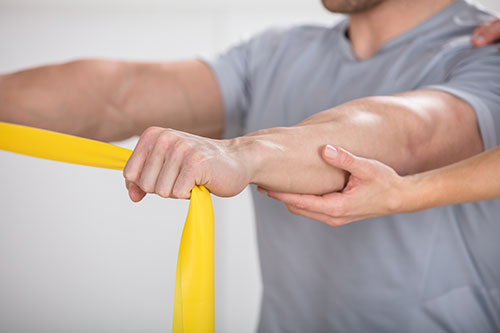About Tennis Elbow
Despite its name, the tennis elbow does not only affect tennis professionals. On the contrary, anyone who forces the forearm or wrist can suffer it and almost 3% of the world’s population suffers it. The symptoms of tennis elbow may persist for more than a year in at least 20% of those affected and prove invalidating.
An early diagnosis and a good physiotherapy Melbourne are necessary to reduce its impact.

What is tennis elbow or epicondylitis?
It is known colloquially as tennis elbow but its medical name is epicondylitis. The suffix ‘itis’ indicates inflammation – peritonitis is inflammation of the peritoneum, tonsillitis of the tonsils, etc. – so the tennis elbow is an inflammation of the epicondylar tendons that unite the muscles of the forearm and the hand with the epicondyle on the lateral lateral aspect of the elbow . This musculature is the one in charge of controlling the main movements of the hand.
Actually, despite its name, the tennis elbow does not imply visible inflammation – hence its symptoms do not include having the elbow swollen – but it is the tendons that are inflamed and cause pain and discomfort .
The epicondylitis has many synonyms: lateral elbow pain, tennis elbow, elbow or golfer rower Tendinosis extensor tendon and peritendinitis elbow joint.
Symptoms of tennis elbow
The usual symptoms of epicondylitis or tennis elbow are:
Pain in the lateral part of the elbow or external part that causes discomfort when making movements like prey or grip in the hand. In general, when loading weights with the palm of the hand upwards, no discomfort will be observed.
Sharp pain if palpating the lateral lateral part of the elbow.
The doctor will verify that the pain reproduces when palpating in the lateral part of the elbow, when stretching the extensor muscles of the wrist and the fingers, and when opposing its contraction.
There are other disorders and diseases that present with pain in the lateral part of the elbow and that are not due to the injury of the tendons as some pathologies of the cervical spine or certain internal alterations of the elbow joint.
Causes of tennis elbow
Epicondylitis is frequent. It affects between 1 and 3% of the general population, something more common in the male sex, and is more common in its onset between 40 and 50 years. The highest incidence, as occurs in osteoporosis , occurs in women from 42 to 46 years of age among which one in ten patients tend to affect the dominant limb.
It occurs because of overuse, that is, by repetitive efforts made with the muscles that extend the wrist and fingers and related to daily activities.
The tendons with which these muscles are anchored to the bone, in the lateral part of the elbow, are injured in a prominence called the humeral epicondyle , hence the name of the disease.
Despite being commonly called tennis player syndrome or tennis elbow , racquet sports are the direct cause in only 5% of cases. Since it is related to multiple occupations (office workers, housework, construction, gardening, carpentry, boilermakers, etc.)
In general, epicondylitis is a disease with good prognosis, but it is common for its symptoms to persist for several months before finally healing. In 20% of patients, symptoms may persist beyond 18 months.
Tennis Elbow Treatment
The convenience of performing complementary tests to help the precise diagnosis will be evaluated: simple radiographs, blood tests, ultrasound, magnetic resonance , studies of the cervical spine or electromyograms.
Ultrasound is key in the diagnosis. The ultrasound is important as it allows immediately confirm the diagnosis of epicondylitis, and can be used to guide the injection of substances in the treatment.
The non-surgical treatment of tennis elbow is successful in 95% of patients so that only a few cases will need surgery.
Apply ice when symptoms begin to appear. Later heat may be applied.
Since the tennis elbow has a tendinous origin, rest will also be part of the treatment.
The NSAIDs also have effectiveness in treating tennis elbow either in ointments or tablets.
A tennis elbow physiotherapy will also help reduce discomfort
Finally, a rehabilitation based on stretching contributes to the recovery of the tennis elbow.
Once the condition has improved it is of vital importance to take care of the postural hygiene to avoid that the tennis elbow reappears
Infiltrations guided by ultrasound are more effective and reduce the risk of errors in a significant way.
Orthoses (bracelets) are also used to help discharge the affected tendons.
In certain cases, one or two local injections with corticosteroids can resolve the pain and functional limitation.
Lately the injection of hyaluronic acid or blood plasma from the patient has been introduced in damaged tendons, reaching a success rate of 79% in patients in whom other non-surgical treatments had failed.

 1300 392 552
1300 392 552